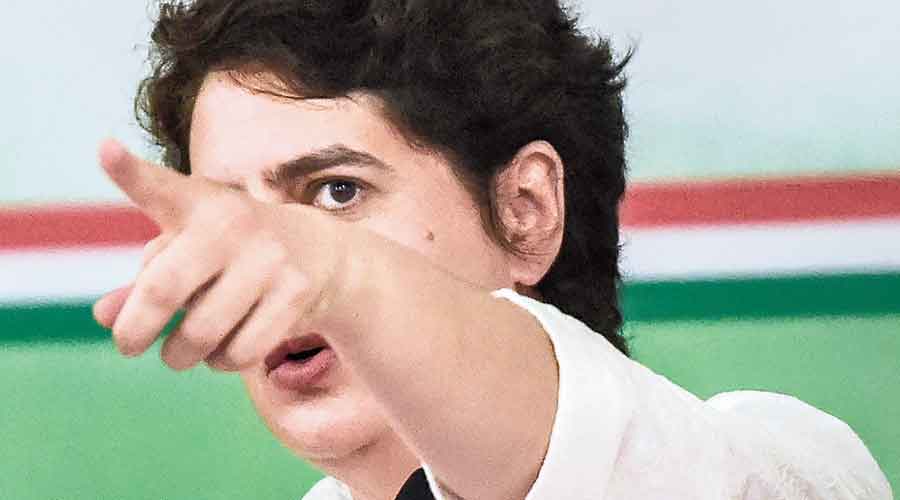Ten women attended the fourth session of the Congress in Bombay in 1889. Since then, the rise in women’s participation in politics has been progressing at a glacial pace with barely 10-15 per cent presence in Parliament, much less in Assemblies, even though India had a woman Prime Minister, a woman President and several women chief ministers.
Of the 10 in 1889, the majority were from Bengal, including Swarnakumari Devi, the poet and Rabindranath Tagore’s sister, and Kadambini Ganguly, one of the first two women graduates from Calcutta University and the first woman doctor of Bengal. Annie Besant became the first woman Congress president in 1917, followed by Sarojini Naidu in 1925, and Mahatma Gandhi later revolutionised mass movements by encouraging the participation of women.
On Tuesday, Priyanka Gandhi Vadra introduced the big idea of giving 40 per cent tickets to women in the Uttar Pradesh Assembly elections.
Political scientist Zoya Hasan told The Telegraph: “This is an innovative, radical idea whose time has come. Giving tickets to woman candidates is one way of increasing representation of women in the political process.”
Hasan, however, did not shy away from pointing out that “I am not sure if this wonderful idea will work. The caste and community issues are so deep-rooted in Uttar Pradesh that introducing gender at this late stage may be a risky gamble. But there should be no dispute on the need for drastically increasing women’s participation in politics.”
Willy-nilly, Priyanka’s move brings back into focus the freedom movement’s glorious legacy of supporting the concept of gender equality — and the dismal picture in contemporary India.
In 1920, Sarojini Naidu led a delegation of the Women’s India Association to England to lobby for voting rights for women. In 1931, at the Karachi session, the Congress passed a resolution to formally grant equal rights to women in all aspects as the stalwarts of the freedom movement felt that women should not suffer any legal infirmity that a man does not face.
India’s Constitution gave women the right to vote at the very outset; women were allowed to vote in America only after a struggle of over 100 years.
Given the sound footing that India started on, the progress has been pathetic.
In 2019, a report placed India towards the bottom of the chart in terms of percentage of women members in Parliament. While Rwanda topped the table with 61 per cent, followed by Mexico (48.2 per cent), Sweden (47.3 per cent) and the US (23.6 per cent), India was behind Pakistan (20.2 per cent) with barely 12.6 per cent members.
The maximum number of women till now (78) was elected in the 2019 parliamentary election.
Even now, Priyanka’s bold decision was received with dismay by many Congress leaders. They privately argued that there are not many woman candidates and such gambles should not be undertaken without sufficient preparation.
Nobody wanted to speak on record but the majority of these Congress leaders felt that the decision would create space for the party in the public discourse and invent a powerful narrative like the Nyay scheme did in 2019, but may not yield immediate electoral dividends.
Preventing women from contesting elections only on the yardstick of perceived “winnability” (as men are more entrenched with money and muscle power) has only strengthened the traditional hierarchies.
But some leaders do believe this move will shake up the electoral pot and seriously challenge the presumption that men are better placed to win. “Right kind of messaging can trigger unexpected reactions from a society which has faced horrors like Unnao and Hathras,” contended Congress Rajya Sabha MP Kumar Ketkar, insisting that all the big ideas witnessed by the Indian polity have been the product of the Congress mind.
Ketkar reeled off a list. “It began with the Avadi resolution piloted by Jawaharlal Nehru in 1955, which gave a decisive socialist turn to Indian politics. Land reforms were badly needed at that time. The dowry prohibition act in 1961, then Indira Gandhi’s bank nationalisation, abolition of the privy purse….
“In 1971, she legalised abortion when it was blasphemy to talk about it in America. In 1972, at the Stockholm earth conference, she made a radical proposal for environmental protection. The Tiger project was entirely her idea. The linguistic reorganisation of states, panchayati raj, economic liberalisation, telecom revolution… the Congress continued to change India.”
Ketkar added: “Don’t forget the historic rights-based legislations by the UPA. Could the Narendra Modi government have brought in the RTI? They are killing the RTI Act. The women’s reservation bill, MGNREGA, the Food Security Act, Right to Education, the Land Acquisition Act… and now 40 per cent reservation for women in tickets. This will change India’s political landscape.”
If the Congress sticks to the plan irrespective of abnormal pressure of realpolitik, a new beginning may indeed be made with far-reaching consequences.












